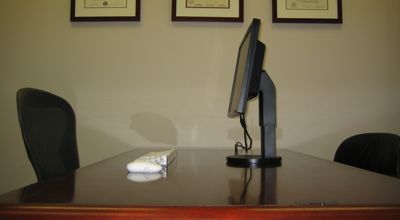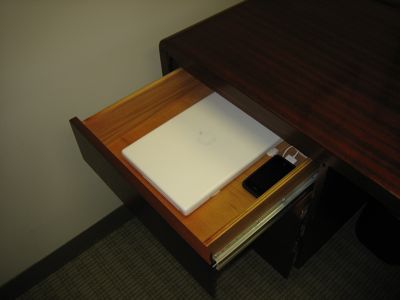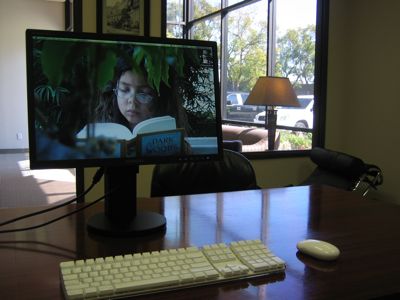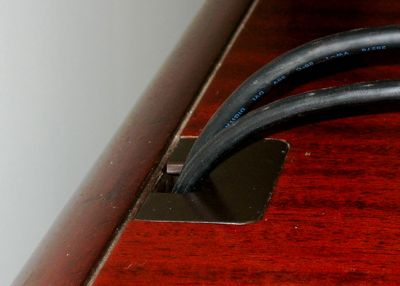Laptop Ergonomics
Wednesday, January 28th, 2009The laptop. That indispensable ergonomic train wreck.
The heaviest laptop users, like pro football players, suffer chonic pain before the age of 30. Unlike pro football players, they are usually not paid millions. How to salve the agony? One solution is the inelegantly named “Laptop in a Drawer.”

22" Samsung monitor with extra high stand, wireless keyboard/mouse, Aeron chair (craigslist, $300), 30x60 cherry desk (free from previous tenant). Laptop is in the desk drawer, lid closed but turned on, driving the whole setup.
WHAT DIDN’T WORK FOR ME
- Docking stations: cumbersome, unwieldy, expensive, ugly, and tied to one laptop brand.
- Two computers: cost more money than one, yet make you less efficient.
WHAT HAS WORKED FOR ME SINCE 2006
- Laptop in desk drawer, turned on, lid closed.
- Bluetooth keyboard and mouse on desk.
- Large ergonomic monitor wired through desk to laptop in drawer.
The result is cheap (if bought used), yet optimizes for function, aesthetics and ergonomics simultaneously. Bring the laptop into the office each day like a wallet (please don’t say purse). Set it in the drawer, lid closed, connect power and monitor, tap the wireless keyboard, laptop wakes up, and you’re on. Takes 10 seconds, and gives you all the advantages of both laptops and desktops.
At the end of the day, just pick up the laptop and go. It’s now charged and backed up (if you use Time Capsule or similar), so you can work elsewhere, yet face zero risk of data loss from theft or damage. Most importantly, these benefits cost you zero time.
More photos of my setup.

13" MacBook Core 2 Duo in desk drawer. Wakes when in range of paired Bluetooth keyboard. Just start typing. At the end of the day, just grab and go.

View out the window from Aeron chair.

Monitor cables threaded through desktop. So that's what those little inserts are for.
I don’t claim this will work for everyone. For example, I have no idea if Windows supports the auto-wake part of this, as Mac does. What I can say is this is cheap — especially if you value your time — and appears to solve all tradeoffs of high-intensity laptop use, with no compromises.
Cooling issue: keep the drawer open a few inches, so you don’t cook your laptop. I have run this way for 2.5 years with no breakdowns, so this may be excessive caution, but in an area that costs me nothing.
—